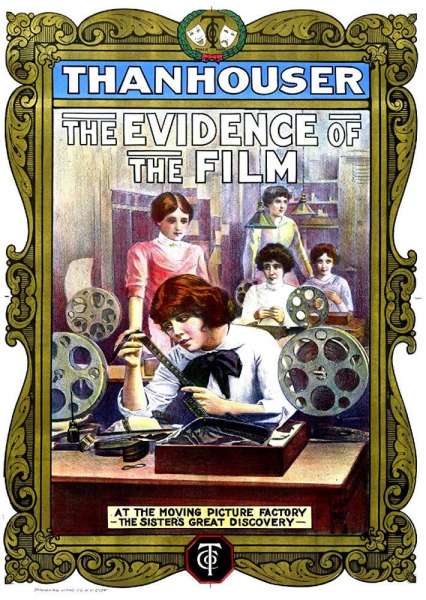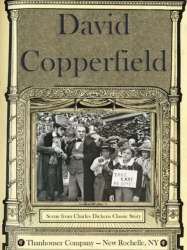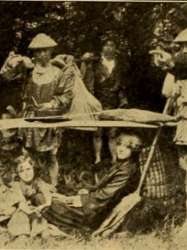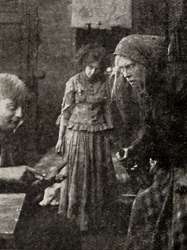The Evidence of the Film is a american film of genre Crime directed by Edwin Thanhouser released in USA on 10 january 1913 with William Garwood
The Evidence of the Film (1913)

If you like this film, let us know!
- Infos
- Casting
- Technical infos
- Photos
- Videos
- Film quotes
- Characters
- Music
- Awards
The Evidence of the Film is a 1913 American silent short crime film directed by Lawrence Marston and Edwin Thanhouser starring William Garwood.
The only known copy of this film was rediscovered in 1999 on the floor of the projection booth in a Superior, Montana movie theater. In 2001, this film was selected for preservation in the United States National Film Registry by the Library of Congress as being "culturally, historically, or aesthetically significant".
Synopsis
The Evidence of the Film tells the story of a messenger boy at a film studio who is wrongfully accused of stealing bonds worth $20,000. He is saved by his sister, a film cutter, who comes across some footage of her brother inadvertently walking into a location shot and being knocked down by the real-life villain.Actors

William Garwood
(The Broker)

Marie Eline
(Messenger Boy)

Florence La Badie
(Sister of Messenger Boy)

Riley Chamberlin
(Clerk)

Mignon Anderson
(Secretary)
Comments
Leave comment :
Suggestions of similar film to The Evidence of the Film
There are 156 films with the same actors, 2 films with the same director, 13832 with the same cinematographic genres, to have finally 70 suggestions of similar films.If you liked The Evidence of the Film, you will probably like those similar films :

Please Help the Pore (1912)
Origin USA
Actors William Garwood, Riley Chamberlin, Mignon Anderson, Marie Eline

David Copperfield (1911)
Directed by George Nichols, Theodore Marston
Origin USA
Genres Drama
Actors Mignon Anderson, Marie Eline, Florence La Badie, Frank Hall Crane, Maude Fealy, William Garwood
Rating60%






Star of Bethlehem (1912)
, 1h46Directed by Lawrence Marston
Origin USA
Genres Drama
Themes Films set in Africa, Christmas films, Films about religion, Films about sexuality, Films based on the Bible, Portrayals of Jesus in film, Films about virginity
Actors Florence La Badie, William Russell, James Cruze, Harry Benham, Justus D. Barnes, David Henry Thompson
Rating50%






The Buddhist Priestess (1911)
Origin USA
Genres Drama, Romance
Actors Marguerite Snow, Marie Eline, Florence La Badie, William Garwood

Under the Gaslight (1914)
Directed by Lawrence Marston
Origin USA
Genres Drama
Themes Films based on plays
Actors Lionel Barrymore, William Russell, Hector Sarno, Thomas Jefferson

At the Foot of the Ladder (1912)
Origin USA
Genres Romantic comedy, Romance
Actors Mignon Anderson, William Garwood, Riley Chamberlin

Her Gallant Knights (1913)
, 10minutesOrigin USA
Genres Comedy, Romantic comedy
Actors William Garwood, Riley Chamberlin, James Cruze, Florence La Badie

The Little Fire Chief (1910)
Origin USA
Actors Marie Eline, William Garwood, Mignon Anderson
Though the film is presumed lost, a synopsis survives in The Moving Picture World from October 29, 1910. It states: "Willie Stone is only six years old, but he yearns to be a fireman. He is much impressed with the parade of firemen he sees in his hometown, so much so in fact that he basely deserts his sister on the streets to follow the 'smoke eaters.' But Willie is only a little boy, and despite his enthusiasm, he is soon weary and footsore. His plight, added to his tears, attracts the attention of a kindly fireman who is driving with his engine back to quarters. The lad's discomfort is soon forgotten, for the fireman gives him a ride back to the engine house. There Willie gravely applies to the captain for a position on the uniformed force, and is jokingly accepted. But he does not see the humor in it and follows the other men to the bunkroom, where he takes part in their sports.

Some Fools There Were (1913)
Directed by Lucius Henderson
Origin USA
Actors Florence La Badie, Jean Darnell, William Garwood, Riley Chamberlin, William Russell

In a Garden (1912)
, 15minutesOrigin USA
Genres Drama, Romance
Actors Riley Chamberlin, Marguerite Snow, James Cruze, Marie Eline, Leland Benham, Harry Benham
Rating54%





Un jardinier est témoin des histoires d'amour, depuis l'enfance, entre miss May et Jack.
 Connection
Connection